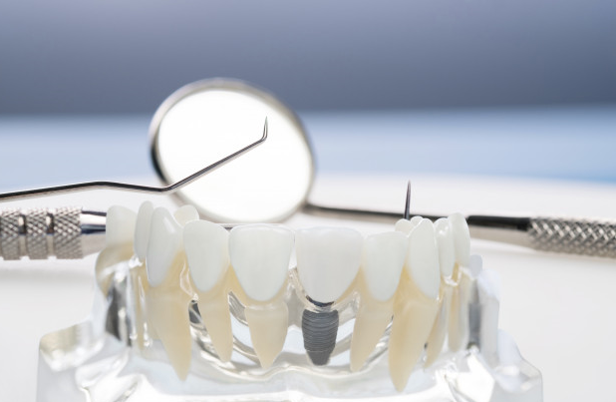– Implant: Titanium made and placed in the upper or lower jawbone.
–Abutment: Made of titanium, gold, or porcelain and attached to the implant by screw. This section attaches the implant to the tooth. Its shape is like a natural tooth that is cut out to fit the crown.
–Restoration (the part that looks like a tooth): A tooth crown. It is usually made from a combination of porcelain with a metal alloy (PFM) but can also be entirely metal or porcelain. The crown is attached to the abutment. If screwed, the screw hole is covered with restorative materials such as tooth-filling composites.

The Procedures of Dental Implant
The time required completing the implant and the crown depends on the different factors. When the conventional dental implants procedure is used, the minimum time to complete the implant period is approximately four months in the lower jaw and nearly six months in the upper jaw, which includes surgery and permanent crown placement. However, this process can take a year or even longer, especially if you first need to build bone.
In another way, the implant and the crown are inserted simultaneously. If the dentist uses small (mini) implants, they will put the bridge and crown in one session, like dentures. These two surgeries need an interval of 2 to 6 months. The first surgical procedure is to make a small incision in the gum (where the dental implant is to be inserted). A drill creates a bone, and the implant is inserted into the hole, then the gum is sutured. After the first surgical recovery period, it is time for the second surgery. The second surgery involves a new incision to reveal the implant. A collar, called healing cap, is screwed to the top of the implant to help repair the tissues around the gums. After a few weeks, the healing cap is removed, and the abutment is screwed onto the implant. Today, a single-stage procedure is sometimes used in which the dentist can perform all the steps of a dental implant, abutment, and permanent crown and bridge in one session. (Immediate implant)

Care and Maintenance of Implants
Maintaining a dental implant is precisely like retaining a natural tooth. After implant surgery, for some time, you will need special care. It is essential to brush and floss daily. If it is necessary, you can use teeth whitening treatment for improving their appearance.
The Faults of Dental Implants
In addition to the surgical risks, it is also possible that your dental implant may not be successful or damaged. If the implant becomes infected, which is very rare or the tooth is not properly fitted, the implant process is not successful. Besides, grinding by the teeth causes a lot of pressure on the implant, which can weaken the bone and break the implant and damage it. If you have any problems with your implants, see the periodontist before your 6-month checkup.
You should know that when the implant is used for the lower teeth, it may damage the nerves in the lower jaw in some cases, and this may cause numbness or tingling. They usually occur on the lower lip, chin, or side of the tongue if they occur. This numbness can be temporary or permanent. But nerve damage is not typical. Photo and CT scans will help the emergency dentist to identify where the nerve is located, which minimizes the chance of injury. In the upper jaw, there is a risk that your sinuses or nasal cavity may be damaged and cause infection. A special x-ray will be taken before your surgery to help your dentist identify the location of the sinuses and nerves.





